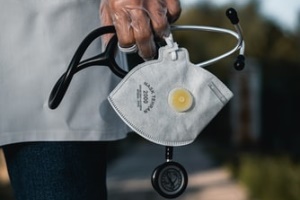The world is facing a once in a generation crisis, its scale matched only by the Spanish Flu pandemic of 1918 to 1920. Citizens face huge restrictions on the way they live their lives, cut off from loved ones and their livelihoods threatened.
Meanwhile, says Paul Marshall, founder and CCO of Eseye, governments the world over battle with huge challenges trying to project and plan for the scale of the crisis, hoping to save as many lives as possible.
From a technology standpoint, the 2020 Coronavirus pandemic has focused the world’s attention on how we’re overcoming social isolation using technology, as well as how it’s helping to reduce the scale of the tragedy and save lives.
From co-working apps allowing us to work remotely and online shopping orders to help us stay at home, to robots treating critically ill patients and deep cleaning the streets, the world, and people, are having to adapt fast in multiple ways both big and small.
The Internet of Things (IoT) has the power to connect the dots between the devices we use in our everyday lives, industry, healthcare, and our cities, for enormous benefit. But what specific benefits can IoT have on mitigating the impact of global pandemics and what innovation needs to be adopted to ensure the world is prepared, should it happen again?
Pain points in a pandemic
Firstly, it’s important to look at the different pain points during a pandemic where human contact needs to be limited, and that IoT and emerging technology may be able to address. Some of these include:
- A lack of real-time data on the number of those infected, the rate the virus is spreading and how it’s being transmitted in the environment. This data is vital in planning a response and choosing where to focus resources.
- The inability to remotely monitor and service key equipment and machinery, especially if it’s part of critical infrastructure
The economic impact of leisure, hospitality and retail businesses having to close their doors to the public and other industries having to ensure their staff can work remotely
- An overburdened medical system and the need to monitor patients remotely to balance care with the availability of bed.
- The spread of the virus through physical contact and in public places
A connected response
How could an IoT connected world work to solve these challenges?
- Whilst IoT devices can help to spot potential symptoms of a virus. By gathering data on both a micro and macro level, governments can identify unusual trends before they become a problem and generate more accurate modelling. This can range from smart city cameras that detect the number of patients with high temperatures, to devices such as a smart ring that can identify Coronavirus symptoms from a wearer. Thanks to cloud computing, data from remote devices all across the world can be managed and interpreted quickly and then made accessible to scientists everywhere, to identify patterns and develop learnings to combat the disease faster.
- Much of the world’s critical infrastructure is unconnected or provides little in the way of remote diagnostics and status updates, let alone the ability to remotely fix these issues. In a pandemic when physical contact needs to be limited and workforces are depleted, it’s vital that the requirement of having engineers on-site is reduced to a minimum. Fully IoT connected devices enable fewer visits and a better ability to solve technical issues remotely, boosting uptime and safeguarding employees from making risky site visits.
- The Coronavirus crisis is forcing businesses to innovate at an incredible rate. Retailers and other non-essential businesses that rely on customers physically entering their stores or outlets are now having to rethink their business models in order to generate revenue. There are several ways IoT can help with this:
- Smart lockers and innovative pick, pack and delivery methods for example, can ease the burden on eCommerce operations which are struggling to cope with the increased demand and create a ‘zero-touch’ approach that makes it easier and safer for business to manage lockdown situations.
- For food and beverage companies, smart vending machines, such as the Costa Express units, can be placed in critical stores such as corner shops, grocery stores and petrol stations which are still allowed to remain open. Connecting these devices using IoT allows for greater business intelligence gathering, live performance monitoring (and alerts to top up consumables to maintain service levels) and the ability to push marketing promotions to devices.
- During a pandemic, healthcare services clearly bear much of the burden as their limited resources are stretched past capacity. IoT can help here in various ways. Remote patient monitoring, for example, means that patients can be monitored from their homes by doctors. One such innovation is Philips Motiva, an interactive TeleHealth platform designed to allow people with chronic conditions to be monitored from the comfort of their own home. This frees up beds and reduces the risk of spreading the virus, but also ensures that if their condition deteriorates, they can quickly be identified and brought into hospital.
- Reducing the need to touch is essential for reducing the spread of viruses. From mobile ordering and contactless payments, to MachineSense’s low-cost, infrared temperature scanning system that negates the need for a human to hold a temperature gun.
The system can be installed in the form of a gate or retrofitted to be installed at any entrance location for the automatic scanning of human body temperature. It allows for proper social distancing and it makes operation safer and less expensive.
The bigger picture
Gathering data on a global scale from people, healthcare devices and from the wider world is essential to limiting the potentially devastating impact of this and future pandemics.

The more data we gather on what happens when a pandemic occurs, the better we can become at modelling the outcome. It’s essential that those with connected devices operating during the Coronavirus outbreak make their data available to researchers, whilst governments need to look at ways in which existing data sources can be leveraged in the future to create a centralised monitoring dashboard that will inform their decisions.
For governments and businesses alike, that are managing unconnected devices, this should serve as a wake-up call that in this modern world, knowledge and insight come through the joined-up approach of connecting devices remotely and analysing the data generated in a safe and meaningful way, to protect the most vulnerable in society.
By doing this, governments will be able to get a better grip on this and future crises and ease the burden on healthcare workers who are saving lives and caring for patients on the front line.
Businesses, meanwhile, will be able to adapt, and protect employees and the public better, even creating new market opportunities to help the economy recover. Data is one of the most powerful tools we have for defeating and adapting to pandemics. Let’s make sure we use it.
The author is Paul Marshall, founder and CCO of Eseye.
Comment on this article below or via Twitter: @IoTNow_OR @jcIoTnow










